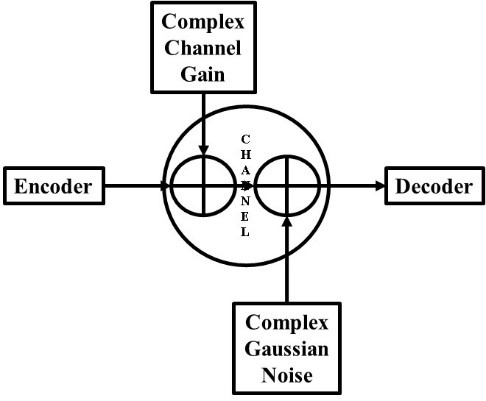Design of Turbo Trellis Coding Modulation Scheme of Rate 4/9 for Rician Fading Channel
Main Article Content
Abstract
When the fading channels are encountered during data communication, errors are likely to occur at the receiving end due to multipath propagation. Researchers have been consistently striving to develop Error Correction Schemes that can effectively handle these errors and ensure error-free data reception at the receiver end. Of particular interest are the Forward Error Correction Schemes that can be implemented at the transmitter end itself. However, the implementation of error correction coding through these schemes incurs additional costs in terms of bandwidth expansion, as extra bits need to be added to facilitate error correction. Fortunately, there exists one coding scheme called Trellis Coded Modulation (TCM), which addresses this issue. TCM selects a modulation scheme based on the rate of the convolutional coding scheme. However, this coding technique has limitations in correcting the number of errors, leading to the development of Turbo Coding. This scheme utilizes two coders at the transmitter, arranged in either serial or parallel configuration, and a suitable decoder at the receiver. A design of Turbo Coding scheme has been presented in this paper, that employs convolutional coders having rate 2/3, in a serially concatenated configuration, providing an effective rate of 4/9. This turbo coding scheme is then applied to TCM scheme in order to preserve the bandwidth. Therefore, if using the convolutional coding scheme of rate 2/3, the modulation scheme is 8-QAM and in order to preserve bandwidth after coding, using the Turbo coding scheme of rate 4/9, then the modulation scheme will be 512-QAM. The simulations have been conducted in MATLAB and the error correcting capabilities of the designed scheme in comparison with convolutional coding scheme using the constituent convolutional encoder have also been compared. It has been observed that in the Rician fading channel conditions, the Turbo Trellis Coding Modulation Scheme provides approximately 5 dB gain compared to the convolutional coding scheme.
Article Details
References
http://en.wikipedia.org/wiki/Forward_error_correction
G. Ungerboeck, “Channel coding with multilevel phase signaling”, IEEE Trans. Inf. Th., vol.IT-25, Jan. 1982, pp.55-67.
C. Berrou, A. Glavieux, and P. Thitimajshima, “Near Shannon limit error-correcting coding and decoding: Turbo-codes”, Proc. Int. Conf. Communications, Geneva, Switzerland, May 1993, pp. 1064–1070.
Takanori Hara, Koji Ishibashi, Soon Xin Ng, Lajos Hanzo, "Low-Complexity Generator Polynomial Search for Turbo Trellis-Coded Spatial Modulation Using Symbol-based EXIT Charts", 2018 IEEE 10th International Symposium on Turbo Codes & Iterative Information Processing (ISTC), pp.1-5, 2018.
Christian B. Schlegel; Lance C. Perez, "Turbo Coding: Basic Principles," in Trellis and Turbo Coding: Iterative and Graph-Based Error Control Coding, IEEE, 2015, pp.351-430, doi: 10.1002/9781119106319.ch8.
Rastogi, A. K. ., Taterh , S. ., & Kumar, B. S. . (2023). Dimensionality Reduction Approach for High Dimensional Data using HGA based Bio Inspired Algorithm. International Journal of Intelligent Systems and Applications in Engineering, 11(2s), 227 –. Retrieved from https://ijisae.org/index.php/IJISAE/article/view/2621
Jamali Hamidreza S. and Tho Le Ngoc, Coded Modulation Techniques for Fading Channels, Boston: Kluwer Academic Publishers, 1994.
[7G. D. Forney, Concatenated Codes, MIT Press, Cambridge, MA, 1966.
Rui Xue, Dan-Feng, Zhao Jie Zhang, “An Improved Method for the Convergence of Iterative Detection in SCCC System” Wireless Communications, Networking and Mobile Computing, 2008. 12-14 Oct. 2008 pp1-5
Ms. Ritika Dhabalia, Ms. Kritika Dhabalia. (2012). An Intelligent Auto-Tracking Vehicle. International Journal of New Practices in Management and Engineering, 1(02), 08 - 13. Retrieved from http://ijnpme.org/index.php/IJNPME/article/view/5
S. Benedetto, D. Divsalar, G. Montorsi and F. Pollara, “A Soft-Input Soft-Output APP Module for Iterative Decoding of Concatenated Codes”, IEEE communications letters, VOL. 1, NO. 1, January 1997 pp 22 – 24
Rajkumar Goswami, SasiBhusana Rao, Rajan Babu, Ravindra Babu, “8 State Rate 2/3 TCM Code Design for Fading Channel” IEEE conference On Control, Communications and Automation, Dec 2008, Vol-II, pp. 323 -326.
Joseph Miller, Peter Thomas, Maria Hernandez, Juan González, Carlos Rodríguez. Exploring Ensemble Learning in Decision Science Applications. Kuwait Journal of Machine Learning, 2(3). Retrieved from http://kuwaitjournals.com/index.php/kjml/article/view/206
Juihong Yuan, B Vucetic and Wen Feng, “Turbo-Coded M-QAM for fading channel”, Electronic Letters, 31 Aug 2000, Vol. 36 No 18, pp 1562 – 1503.

